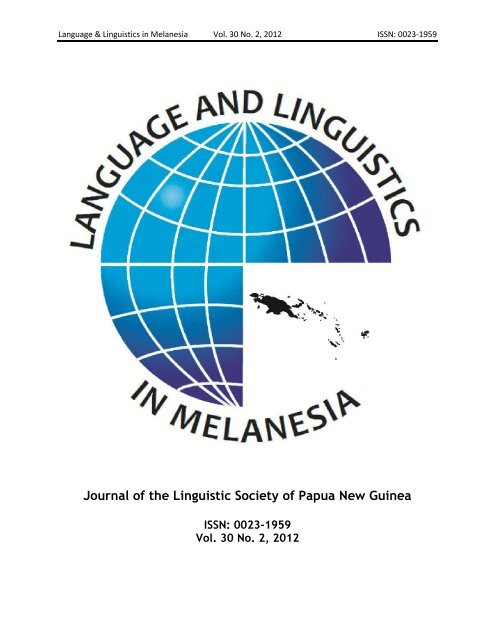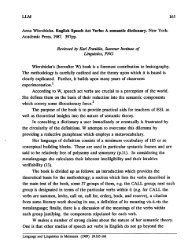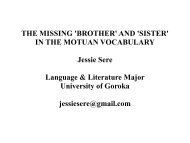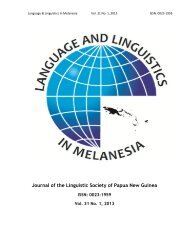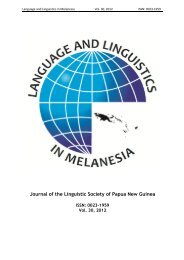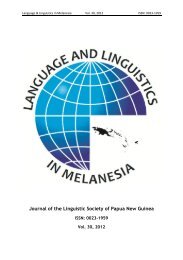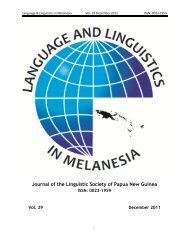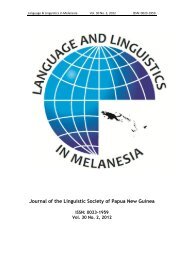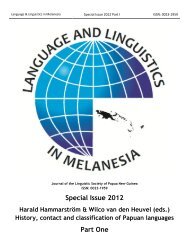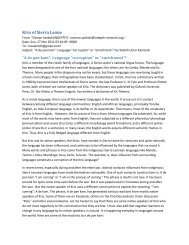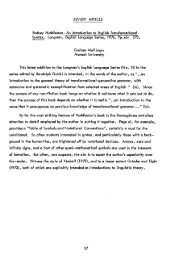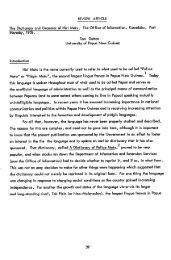Journal of the Linguistic Society of Papua New Guinea
Journal of the Linguistic Society of Papua New Guinea
Journal of the Linguistic Society of Papua New Guinea
Create successful ePaper yourself
Turn your PDF publications into a flip-book with our unique Google optimized e-Paper software.
Language & <strong>Linguistic</strong>s in Melanesia Vol. 30 No. 2, 2012 ISSN: 0023-1959<br />
<strong>Journal</strong> <strong>of</strong> <strong>the</strong> <strong>Linguistic</strong> <strong>Society</strong> <strong>of</strong> <strong>Papua</strong> <strong>New</strong> <strong>Guinea</strong><br />
ISSN: 0023-1959<br />
Vol. 30 No. 2, 2012<br />
30
Language & <strong>Linguistic</strong>s in Melanesia Vol. 30 No. 2, 2012 ISSN: 0023-1959<br />
Syntax through <strong>the</strong> Wide-Angle Lens <strong>of</strong> Dialectics<br />
By Olga Temple<br />
<strong>Linguistic</strong>s & Modern Languages<br />
School <strong>of</strong> Humanities & Social Sciences<br />
UPNG<br />
olga.temple77@gmail.com<br />
Abstract<br />
I contend that we cannot understand <strong>the</strong> structures <strong>of</strong> language (verbal thought), if we do not<br />
understand <strong>the</strong> mechanism <strong>of</strong> human thought. After a brief look at traditional syntactic <strong>the</strong>ory, I<br />
propose a model <strong>of</strong> sentence analysis (G-nalysis), which, I argue, better serves language users – <strong>the</strong><br />
‘spinners’ <strong>of</strong> <strong>the</strong>ir ‘webs <strong>of</strong> significance.’<br />
In contrast to <strong>the</strong> purely descriptive approach to language, aimed at documenting its fleeting physical<br />
forms, G-nalysis tries to identify <strong>the</strong> logical relationships, <strong>the</strong> functions <strong>of</strong> words and groups <strong>of</strong> words<br />
(phrases and clauses) in <strong>the</strong> nexus <strong>of</strong> <strong>the</strong> sentence. Expounding on <strong>the</strong> two universal principles <strong>of</strong><br />
sentence structure (syn<strong>the</strong>sis and analysis), and showing how <strong>the</strong>y operate in all human languages, I<br />
argue that dialectics facilitates students’ understanding <strong>of</strong> syntax at all levels <strong>of</strong> education.<br />
Specifically, I argue in favour <strong>of</strong> adopting G-nalysis in <strong>the</strong> teaching <strong>of</strong> grammar in secondary schools – in<br />
<strong>Papua</strong> <strong>New</strong> <strong>Guinea</strong> and beyond.<br />
Keywords: generalization, dialectics, dialectical linguistics, syntax, syntactic analysis, meaning, ambiguity<br />
I. TRADITIONAL WORD-BASED PRESCRIPTIVE GRAMMAR<br />
Traditionally, word-based prescriptive grammars distinguished eight parts <strong>of</strong> speech by individual<br />
words’ functions in <strong>the</strong> sentence (that is, by ‘what a word does in a sentence’):<br />
Word<br />
Nouns<br />
Pronouns<br />
Adjectives<br />
Verbs<br />
Adverbs<br />
Conjunctions<br />
Prepositions<br />
Interjections<br />
Function<br />
name things<br />
stand instead <strong>of</strong> nouns<br />
describe (modify) nouns<br />
‘action’ words<br />
describe verbs & adjectives<br />
join words, phrases & clauses<br />
Are <strong>the</strong> ‘connective tissue’; <strong>the</strong>y show <strong>the</strong> ‘positions’ <strong>of</strong> things in space and time<br />
expressions <strong>of</strong> speakers’ feelings & attitudes interjected, or ‘thrown into’ <strong>the</strong> midst <strong>of</strong> a<br />
clause: <strong>the</strong> ‘SPICES’<br />
The close-up focus on <strong>the</strong> functions <strong>of</strong> individual words, viewed in isolation even in <strong>the</strong> context <strong>of</strong> <strong>the</strong><br />
sentence, overlooked <strong>the</strong> fluid nature <strong>of</strong> word-meanings in use, <strong>the</strong> multi-layered relationships between<br />
word-meanings in <strong>the</strong> sentence mosaic. Singular focus on single words misses <strong>the</strong> forest for <strong>the</strong> trees!<br />
31
Language & <strong>Linguistic</strong>s in Melanesia Vol. 30 No. 2, 2012 ISSN: 0023-1959<br />
II. DESCRIPTIVE SYNTAX<br />
In an attempt to capture <strong>the</strong> relationships between words in <strong>the</strong> sentence, descriptive linguistics<br />
widened <strong>the</strong> scope <strong>of</strong> <strong>the</strong> ‘Parts <strong>of</strong> Speech’ concept to include groups <strong>of</strong> words (phrases), viewed as<br />
categories <strong>of</strong> lexical items defined by <strong>the</strong>ir morphological or syntactic behavior (Tallerman: 1998, p.<br />
31). Major word classes, such as Verb Phrase (VP), Noun Phrase (NP), Adjective Phrase (Adj.P), and<br />
Prepositional Phrase (PP), are distinguished by <strong>the</strong> morphology, functions, and patterns <strong>of</strong> distribution<br />
<strong>of</strong> phrase ‘heads’ [this covers both <strong>the</strong> slots <strong>the</strong> words can appear in and <strong>the</strong> modifiers that co-occur<br />
with <strong>the</strong>m]. Because <strong>of</strong> <strong>the</strong> primary focus on single words (like ‘heads’ in a phrase), and because<br />
languages vary so widely in <strong>the</strong>ir physical structures, descriptive syntactic analysis concludes that word<br />
classes in different languages also vary:<br />
‘…Groups <strong>of</strong> closed class words <strong>of</strong>ten pair up with a specific lexical word, such as noun or an<br />
adjective. To count as a distinct word class, a set <strong>of</strong> words must have some properties which<br />
distinguish <strong>the</strong>m from o<strong>the</strong>r word classes in <strong>the</strong> language. If we don’t find any such properties,<br />
<strong>the</strong>n it would be unscientific to make artificial divisions in <strong>the</strong> data. … It is important … not to<br />
expect all languages to look <strong>the</strong> same. For instance, we shouldn’t think that just because, say,<br />
English and Italian have an open class <strong>of</strong> adjectives, <strong>the</strong>n all languages must have one. On <strong>the</strong><br />
o<strong>the</strong>r hand, linguists now know that languages don’t vary from each o<strong>the</strong>r at random. We can<br />
expect <strong>the</strong>re to be a finite set <strong>of</strong> possible different word classes, from which each language<br />
‘selects’ its own set <strong>of</strong> classes’ (Tallerman: 1998, p. 49).<br />
Based strictly on morphological description, <strong>the</strong> Igbo language <strong>of</strong> Nigeria appears to have only eight<br />
adjectives, 1 while o<strong>the</strong>r languages have ‘very few or even no prepositions’ (Tallerman: 1998, p. 34) –<br />
Latvian, for example, has no preposition ‘in’!<br />
The sheer diversity <strong>of</strong> linguistic forms seemingly contradicts <strong>the</strong> idea <strong>of</strong> universal principles <strong>of</strong> human<br />
understanding which underlie and actively shape <strong>the</strong> grammars <strong>of</strong> all human languages. Yet, we know<br />
that looks can be deceptive – to paraphrase Shakespeare, ‘What’s in a form’ All human languages,<br />
regardless <strong>of</strong> <strong>the</strong>ir physical forms, express <strong>the</strong> same logical relationships that human minds see between<br />
things in our 4-D physical world – relationships based on resemblance, contiguity in space/time, and<br />
causality. Latvian may lack <strong>the</strong> preposition ‘in’, but that does not mean that this spatial relationship does<br />
not exist in Latvian minds; it simply means that <strong>the</strong> speakers use a different way <strong>of</strong> expressing it:<br />
Nominative: galds (table) Locative: galdaa (in <strong>the</strong> table)<br />
aviize (newspaper)<br />
aviizee (in <strong>the</strong> newspaper)<br />
While <strong>the</strong> forms <strong>of</strong> <strong>the</strong> physical structures (morphology) differ, <strong>the</strong>ir essence (meaning) remains <strong>the</strong><br />
same. Formal tests used to categorize phrases by <strong>the</strong> morphological ‘looks’ and patterns <strong>of</strong> distribution<br />
1 ‘Igbo has 8 adjectives (<strong>the</strong>y are actually converses); <strong>the</strong> English equivalents are: hot/cold; young/old; black/white;<br />
beautiful/ugly. The 'dispute' however rests on nouns that function as adjectives which some linguists insist should<br />
be classified as adjectives’ (Pr<strong>of</strong>. Ogunkeye, Funmi: <strong>Linguistic</strong>s, University <strong>of</strong> Jos, Nigeria).<br />
32
Language & <strong>Linguistic</strong>s in Melanesia Vol. 30 No. 2, 2012 ISSN: 0023-1959<br />
<strong>of</strong> <strong>the</strong>ir ‘heads’ lose sight <strong>of</strong> <strong>the</strong> actual grammatical meaning <strong>of</strong> <strong>the</strong> phrases, <strong>of</strong> <strong>the</strong>ir collective function.<br />
By implication, Kwamera adjectives, indeed, must be viewed as verbs, while in Igbo <strong>the</strong>y become nouns<br />
(Tallerman: 1998, pp. 44-45). René van den Berg and Robert Busenitz, <strong>the</strong> authors <strong>of</strong> <strong>the</strong> recently<br />
published Grammar <strong>of</strong> Balantak, a language <strong>of</strong> Eastern Sulawesi , make a more nuanced claim that<br />
“Adjectival concepts (such as ‘big’, ‘good’ and ‘red’) are treated as stative verbs in Balantak,” and agree<br />
that <strong>the</strong> twelve word classes <strong>the</strong>y distinguish for Balantak 2 may not be <strong>the</strong> only conceivable classification<br />
(René van den Berg & Robert L. Busenitz: 2012, p. 27). Categorizing words by <strong>the</strong>ir ‘looks’ (morphology /<br />
syntactic distribution) and ‘fixed’ grammatical functions, assigned to <strong>the</strong>m outside <strong>of</strong> each sentence<br />
mosaic, is indeed bound to be subjective to individual perception, for we all view <strong>the</strong> world through our<br />
own Mind’s Eye and make sense <strong>of</strong> things in our own heads, based on our own personal experience. Yet,<br />
descriptive linguistic analysis has been generally deemed to reflect scientific facts.<br />
I will argue that we cannot understand a complex whole (such as human language) by focusing on its<br />
parts (phonology, morphology, syntax, semantics, etc.)<br />
– ‘The Whole is more than <strong>the</strong> sum <strong>of</strong> its parts’<br />
(Aristotle: Metaphysics, Book I). Despite acknowledging<br />
<strong>the</strong> overlap between syntax and semantics, descriptive<br />
linguistics has separated <strong>the</strong> two: syntactic <strong>the</strong>ory, as<br />
illustrated above, focuses on <strong>the</strong> mechanical description<br />
<strong>of</strong> physical structures, while propositional semantic<br />
<strong>the</strong>ories view sentences and <strong>the</strong>ir parts as bearers <strong>of</strong><br />
some fixed ‘objective’ meaning, and attempt to pair <strong>the</strong><br />
two, using Frege’s Theory <strong>of</strong> Reference adjusted, in <strong>the</strong><br />
case <strong>of</strong> double-indexing semantics, for propositional<br />
attitude ascription and circumstances <strong>of</strong> evaluation 3 .<br />
Ferdinand de Saussure dissected <strong>the</strong> <strong>Linguistic</strong> Sign into<br />
word and meaning (<strong>the</strong> Signifier and <strong>the</strong> Signified), and<br />
examined its ‘body’ and ‘soul’ separately, fixed in time,<br />
lifeless. Descriptive linguistics does virtually <strong>the</strong> same,<br />
only it dissects <strong>the</strong> larger units <strong>of</strong> language (propositions), and tries to pair <strong>the</strong>m with <strong>the</strong>ir ‘objective’<br />
meanings.<br />
However, sentence-meanings cannot be ‘fixed’ in dictionaries. Sentence meaning is not merely <strong>the</strong> sum<br />
total <strong>of</strong> <strong>the</strong> word meanings in it – it is <strong>the</strong> mosaic image <strong>the</strong> words make that people ‘see’ through <strong>the</strong><br />
lens <strong>of</strong> <strong>the</strong>ir own individual experience. The meaning <strong>of</strong> a sentence mosaic is a complex<br />
image/generalization, and each Mind’s Eye may see <strong>the</strong> ‘picture’ shaped by <strong>the</strong> grammatical relations<br />
between words in <strong>the</strong> sentence differently – this makes language inherently ambiguous. Look, for<br />
example, at this image above – people with normal eyesight will see Einstein, whereas near-sighted<br />
people will see Marilyn Monroe. Likewise, <strong>the</strong> vision <strong>of</strong> each Mind’s Eye and, <strong>the</strong>refore, what it actually<br />
2 nouns, verbs, pronouns, articles, demonstratives, numerals, quantifiers, adverbs, prepositions, conjunctions,<br />
interjections, and particles<br />
3 Quine (1970), Kripke (1972), Kaplan (1989), et al.<br />
33
Language & <strong>Linguistic</strong>s in Melanesia Vol. 30 No. 2, 2012 ISSN: 0023-1959<br />
‘sees’, varies according to individual experience (i.e., level <strong>of</strong> cognitive development, physical and<br />
psychological state, social and cultural environment, and circumstances <strong>of</strong> communication).<br />
Ano<strong>the</strong>r example <strong>of</strong> ‘indeterminacy’ <strong>of</strong> word meanings in use:<br />
What you see as <strong>the</strong> ‘hands’ <strong>of</strong> <strong>the</strong> highwayman below could as well have been <strong>the</strong> fins <strong>of</strong> a fish, or <strong>the</strong><br />
feet <strong>of</strong> a duck in ano<strong>the</strong>r pattern; it is <strong>the</strong> ‘picture’ that each Mind’s Eye sees which makes parts <strong>of</strong> <strong>the</strong><br />
whole to be what <strong>the</strong>y are in each person’s understanding.<br />
Photos taken in a Highlands hotel (FB): East Sepik highwaymen Gents’ toilet sign<br />
Descriptive syntax ignores <strong>the</strong> process <strong>of</strong> generalization which puts parts <strong>of</strong> <strong>the</strong> mosaic image toge<strong>the</strong>r,<br />
shaping <strong>the</strong> sentence meaning in our minds. In order to understand linguistic structures, we must<br />
understand <strong>the</strong> forces that put <strong>the</strong>m toge<strong>the</strong>r – associations by resemblance, contiguity, and<br />
cause/effect, <strong>the</strong> principles <strong>of</strong> human understanding (Hume: 1748). “We do not regard any <strong>of</strong> <strong>the</strong> senses<br />
as Wisdom,” wrote Aristotle, “yet surely <strong>the</strong>se give <strong>the</strong> most authoritative knowledge <strong>of</strong> particulars. But<br />
<strong>the</strong>y do not tell us <strong>the</strong> 'why' <strong>of</strong> anything - e.g., why fire is hot; <strong>the</strong>y only say that it is hot. … Wisdom is<br />
knowledge about certain principles and causes” (Aristotle: Metaphysics, Book I). Detailed accounts <strong>of</strong><br />
and descriptions <strong>of</strong> linguistic structures provide us with useful information that sharp senses <strong>of</strong> hearing<br />
and sight can give us. They cannot explain <strong>the</strong>ir ‘principles and causes’ – <strong>the</strong> ‘why’s <strong>of</strong> <strong>the</strong> constantly<br />
changing grammars.<br />
III. DIALECTICAL SYNTAX<br />
Dialectical syntax describes <strong>the</strong> different ways societies devised <strong>of</strong> doing <strong>the</strong> same thing – generalizing,<br />
or thinking (i.e., associating word-meanings by resemblance, contiguity and cause/effect, thus<br />
syn<strong>the</strong>sizing larger chunks <strong>of</strong> meaning – phrases and clauses). This Rational Language Mechanism, so<br />
elegant in its simplicity, operates without exception in all human languages. Different grammars use<br />
different tactics to build <strong>the</strong>ir sentence mosaics, but <strong>the</strong> strategy <strong>of</strong> syn<strong>the</strong>sizing complex<br />
generalizations through only three types <strong>of</strong> association is universal. Look, for example, how different<br />
languages express <strong>the</strong> same causal relationship in so many changing ways:<br />
34
Language & <strong>Linguistic</strong>s in Melanesia Vol. 30 No. 2, 2012 ISSN: 0023-1959<br />
English:<br />
‘I think, <strong>the</strong>refore, I am’:<br />
Yoruba: Mo wa láàyè nitoripé mo n ronú.<br />
I be alive for reason that (because) I Asp:think<br />
Mo n ronú nítorí náà mo wa láàyè<br />
I Asp:think for reason that (for that reason /<strong>the</strong>refore) I<br />
be alive<br />
Krio:<br />
Japanese:<br />
Latvian:<br />
German:<br />
Dutch:<br />
Russian:<br />
Ah de tink, so na mi.<br />
Ware omou, yueni ware ari.<br />
Watashi wa kangaemasu, dakara watashi wa sonzai shimasu.<br />
Es domāju – tādēļ es esmu.<br />
Ich denke, also bin ich.<br />
Ik denk, daarom ik besta.<br />
Я мыслю, следовательно, я существую.<br />
Greek: Σκέφτομαι άρα υπάρχω .<br />
Bahasa Indonesia:<br />
Mussau:<br />
Telei <strong>of</strong> S. Bougainville:<br />
Tolai:<br />
Saya pikir, mahanya Saya ada.<br />
Aghi nongina, aghi anna.<br />
Nne aposi, eguko nne.<br />
Iau nukia, ba iau iau.<br />
Language is a social means <strong>of</strong> verbal thought, a collectively created ‘spinning wheel’ which its speakers<br />
use to spin <strong>the</strong>ir unique ‘webs <strong>of</strong> significance.’ When every word <strong>of</strong> language is viewed as an act <strong>of</strong><br />
thought, words come alive as <strong>the</strong> generalizations <strong>of</strong> our living, thinking collective minds; toge<strong>the</strong>r, <strong>the</strong>y<br />
form <strong>the</strong> yarn <strong>of</strong> collective generalizations (word-meanings), out <strong>of</strong> which Individuals spin <strong>the</strong>ir ‘webs’<br />
(sentence meanings). The contradictions inherent in <strong>the</strong> complex whole <strong>of</strong> language, its psycho-physical,<br />
social-individual and historical dualities, power its beating heart (generalization), thus forming <strong>the</strong><br />
‘Rational Mechanism’ <strong>of</strong> language (Temple: 2009, 2011).<br />
Since syntax is basically <strong>the</strong> conventional way <strong>of</strong> generalizing, dialectical analysis uses <strong>the</strong> universal<br />
principles <strong>of</strong> human understanding to unravel <strong>the</strong> intricacies <strong>of</strong> linguistic forms. Through <strong>the</strong> wide-angle<br />
perspective, <strong>the</strong> traditional ‘parts <strong>of</strong> speech’ are seen as <strong>the</strong> natural associations in human minds:<br />
adjectives connect ideas by resemblance; adverbs – by resemblance, contiguity, or cause/effect, and<br />
nouns are conceived by all three kinds <strong>of</strong> association. Traditional abstract concepts (‘parts <strong>of</strong> speech’)<br />
thus become concrete manifestations <strong>of</strong> verbal thought /human understanding <strong>of</strong> <strong>the</strong> physical world. In<br />
contrast to traditional word-based grammar, dialectical syntax recognizes that groups <strong>of</strong> words can form<br />
‘chunks’ <strong>of</strong> meaning and that, <strong>the</strong>refore, groups <strong>of</strong> words (phrases and clauses) can perform one<br />
35
Language & <strong>Linguistic</strong>s in Melanesia Vol. 30 No. 2, 2012 ISSN: 0023-1959<br />
function (Noun, Adjective or<br />
Adverb). In this floor mosaic<br />
in Dallas International<br />
Airport (photo taken in<br />
02/2012), it is groups <strong>of</strong> tiles<br />
that toge<strong>the</strong>r form <strong>the</strong> bird’s<br />
wings, tail, eye, beak, etc.:<br />
Generalizing syntactic<br />
analysis (G-nalysis) focuses<br />
on how words and groups <strong>of</strong><br />
words function in <strong>the</strong><br />
sentence, forming chunks <strong>of</strong><br />
meaning in <strong>the</strong> overall<br />
sentence mosaic. Associating ideas by resemblance, contiguity, and cause/effect comes to us naturally,<br />
because our thoughts reflect our experiences in <strong>the</strong> 4-D physical world – we perceive resemblance<br />
between things, and <strong>the</strong> various spatial, temporal and causal relationships between <strong>the</strong>m. The so-called<br />
‘journalistic’ questions ‘Who, Does What, to Whom, How, When, Where, and Why’ reflect <strong>the</strong><br />
relationships between <strong>the</strong> things we observe; word-meanings that answer <strong>the</strong>se questions (singly or<br />
‘working toge<strong>the</strong>r’ in groups) are classed as different ‘Parts <strong>of</strong> Speech,’ depending on what <strong>the</strong>y do in<br />
<strong>the</strong> sentence/ which question <strong>the</strong>y answer:<br />
Word Function Answer Questions:<br />
Nouns Words/phrases/clause that name things What Who<br />
Pronouns stand instead <strong>of</strong> nouns What Who<br />
Adjectives<br />
Verbs<br />
Words/ phrases/ clauses that describe nouns by<br />
RESEMBLANCE<br />
Which What kind<br />
name actions or states <strong>of</strong> being, while carrying also <strong>the</strong> meaning <strong>of</strong> time [SYNTHESIS/<br />
CONJUGATION with SUBJECT]:<br />
A verb is that which, in addition to its proper meaning, carries with it <strong>the</strong> notion <strong>of</strong> time … It is a<br />
sign <strong>of</strong> something said <strong>of</strong> something else. (Aristotle)<br />
Adverbs<br />
Conjunctions<br />
describe verbs by<br />
RESEMBLANCE:<br />
CONTIGUITY I in space/time:<br />
CAUSE/EFFECT:<br />
*Adverbs also describe adjectives (qualities)<br />
join words, phrases & clauses [CONTIGUITY]<br />
How<br />
Where When<br />
Why With what<br />
consequence On what<br />
condition et cetera<br />
Prepositions<br />
Interjections<br />
Are <strong>the</strong> ‘connective tissue’; <strong>the</strong>y show relative ‘positions’ <strong>of</strong> things in space and time<br />
[CONTIGUITY]<br />
expressions <strong>of</strong> speakers’ feelings & attitudes interjected, or ‘thrown into’ <strong>the</strong> midst <strong>of</strong> a<br />
clause: <strong>the</strong> ‘SPICES’<br />
36
Language & <strong>Linguistic</strong>s in Melanesia Vol. 30 No. 2, 2012 ISSN: 0023-1959<br />
Thus, <strong>the</strong> associations that drive <strong>the</strong> process <strong>of</strong> thought result in generalization on multiple levels: word,<br />
phrase, clause, sentence, and larger discourse. Dialectical syntax uses <strong>the</strong> principles <strong>of</strong> human<br />
understanding to identify <strong>the</strong> grammatical functions <strong>of</strong> words and groups <strong>of</strong> words (those ‘chunks’ <strong>of</strong><br />
meaning, phrases and clauses) in <strong>the</strong> main sentence.<br />
Apart from <strong>the</strong> simplicity <strong>of</strong> using <strong>the</strong> natural logic <strong>of</strong> human thought in syntactic analysis, <strong>the</strong> dialectical<br />
method has ano<strong>the</strong>r pedagogical advantage over <strong>the</strong> traditional word-based or phrase structure<br />
grammar approaches – it uses very few terms and concepts, i.e.:<br />
<br />
<br />
<br />
<br />
<br />
<br />
The traditional 8 parts <strong>of</strong> speech<br />
The sentence = ‘saying something about something’<br />
The S/V/C nexus, in whichever order <strong>the</strong>y come; *‘C’ is for ‘Complement’ in preference to <strong>the</strong><br />
conventional ‘O’ for ‘Object’ because this slot in <strong>the</strong> nexus can also be filled by Predicate<br />
Adjectives and Predicate Nouns, or remain empty, have Zero Complement (Vavra: 2000)<br />
Noun, Adjective, & Adverb phrases /dependent clauses, <strong>the</strong> difference between <strong>the</strong> two being<br />
strictly structural (both are groups <strong>of</strong> words that function as one part <strong>of</strong> speech, Adjective,<br />
Adverb, or Noun; however, clauses have nexal patterns <strong>of</strong> <strong>the</strong>ir own, whereas phrases do not)<br />
Four types <strong>of</strong> sentence structure: (1) Simple – one nexal pattern; (2) Compound – two or more<br />
independent nexal patterns, joined toge<strong>the</strong>r by conjunctions or commas; (3) Complex – one<br />
independent nexal pattern and one or more dependent clauses; (4) Compound-Complex – two<br />
or more independent nexal patterns and one or more dependent clauses.<br />
The two universal principles <strong>of</strong> sentence structure:<br />
o Syn<strong>the</strong>sis <strong>of</strong> what we speak about with what we say about it [<strong>the</strong> nexus <strong>of</strong> <strong>the</strong> Subject,<br />
Verb & Compliment (S/V/C), in whichever order <strong>the</strong>y come], and<br />
o Analysis (aka Modification/Recursion): adding detail, ‘color’/‘pixels’ to any <strong>of</strong> <strong>the</strong> major<br />
sentence constituents (S/V/C).<br />
In addition to <strong>the</strong>se common-sense concepts, a few acronyms, or abbreviations, will facilitate sentence<br />
diagramming:<br />
S<br />
V<br />
C<br />
PA<br />
PN<br />
DO<br />
IO<br />
C zero<br />
= Subject<br />
= Verb<br />
= Compliment<br />
= Predicate Adjective<br />
= Predicate Noun<br />
= Direct Object<br />
= Indirect Object<br />
= Zero Compliment<br />
IV. GENERALIZING SENTENCE ANALYSIS (G-NALYSIS)<br />
G-nalysis aims to identify <strong>the</strong> associations in <strong>the</strong> speakers’ minds that glue word-meanings into larger<br />
chunks <strong>of</strong> meaning (phrases/clauses). The syn<strong>the</strong>sis <strong>of</strong> generalization holds sentence mosaics toge<strong>the</strong>r.<br />
The analysis <strong>of</strong> generalization ‘zooms in’ on parts <strong>of</strong> <strong>the</strong> nexus ‘mosaic’, adding detail, colur to <strong>the</strong> major<br />
37
Language & <strong>Linguistic</strong>s in Melanesia Vol. 30 No. 2, 2012 ISSN: 0023-1959<br />
sentence constituents, increasing <strong>the</strong>ir pixel resolution. ‘Generalizing’ syntactic analysis aims to<br />
elucidate both aspects <strong>of</strong> <strong>the</strong> process; <strong>the</strong>refore, G-nalysis uses a two-step procedure:<br />
1. The first step is to identify <strong>the</strong> major ‘parts’ <strong>of</strong> all <strong>the</strong> nexal patterns present in <strong>the</strong> overall<br />
syn<strong>the</strong>sis (sentence mosaic).<br />
2. The second step, once all <strong>the</strong> S/V/C patterns have been identified, is to figure out how all <strong>the</strong><br />
clauses (S/V/Cs), phrases, and words relate to each o<strong>the</strong>r – what do <strong>the</strong>y actually do in <strong>the</strong><br />
sentence This is done by asking <strong>the</strong> relevant logical questions, which will identify <strong>the</strong> function/<br />
‘part <strong>of</strong> speech’ <strong>of</strong> <strong>the</strong> word, phrase, or clause in <strong>the</strong> sentence.<br />
Relationships between nexal patterns are indicated by simple diagrams, where quadrangles represent<br />
independent SVCs, and triangles – dependent SVCs:<br />
C 1(PA) +(IO), not (IO)<br />
S 1 V 1 C 1(PA) C 2 (IO) S 2 V 2 C 3(IO) S 3 V 3<br />
// I / am / only responsible for what / I / say /, not /for what / you / understand //.<br />
How What What<br />
S 1 V 1 C 1<br />
Two Noun Clauses = Indirect Objects embedded in <strong>the</strong> Complement 1 slot<br />
not<br />
Re-cap <strong>of</strong> G-nalysis basics:<br />
It is <strong>the</strong> common function (purpose, <strong>the</strong> fusion <strong>of</strong> semantic and grammatical meaning) <strong>of</strong> words working<br />
toge<strong>the</strong>r that binds <strong>the</strong>m into a unit <strong>of</strong> compound meaning, ei<strong>the</strong>r naming something in <strong>the</strong> nexus<br />
(noun function) or adding detail to a sentence constituent (adjective or adverb function).<br />
Phrases are different from dependent clauses only structurally: while clauses have <strong>the</strong>ir own nexal<br />
patterns (S/V/Cs), phrases do not; both phrases and dependent clauses are defined by <strong>the</strong>ir common<br />
function: words in <strong>the</strong>m work toge<strong>the</strong>r as one part <strong>of</strong> speech (noun, adjective, or adverb).<br />
Thus, <strong>the</strong> universal Rational Mechanism <strong>of</strong> Language (generalization) works through <strong>the</strong> syn<strong>the</strong>sis <strong>of</strong><br />
word-meanings into <strong>the</strong> nexus <strong>of</strong> <strong>the</strong> sentence and analysis (description, modification, specification) <strong>of</strong><br />
<strong>the</strong> nexus constituents:<br />
<br />
<br />
Syn<strong>the</strong>sis connects <strong>the</strong> ‘bones’ <strong>of</strong> <strong>the</strong> ‘skeleton’ into <strong>the</strong> ‘Subject, Verb, Complement’ pattern <strong>of</strong><br />
<strong>the</strong> proposition; <strong>the</strong>ir nexus (in whichever order <strong>the</strong>y come)represents <strong>the</strong> linear (syntagmatic)<br />
relationship between <strong>the</strong>m, and<br />
Analysis zooms in on <strong>the</strong> major parts <strong>of</strong> <strong>the</strong> sentence mosaic & describes <strong>the</strong>m by resemblance,<br />
cause/effect & contiguity in space/time – it puts ‘flesh’ on <strong>the</strong> bones <strong>of</strong> <strong>the</strong> sentence.<br />
38
Language & <strong>Linguistic</strong>s in Melanesia Vol. 30 No. 2, 2012 ISSN: 0023-1959<br />
Meaning-as-Use<br />
‘In use, words and <strong>the</strong>ir meanings are relatively<br />
independent <strong>of</strong> each o<strong>the</strong>r’ (Vygotsky: 1934); in fact, words<br />
only acquire <strong>the</strong>ir true meaning in <strong>the</strong> nexus <strong>of</strong> <strong>the</strong><br />
proposition, just like <strong>the</strong> nose in this line drawing is<br />
different from <strong>the</strong> eyes solely by virtue <strong>of</strong> its position in <strong>the</strong><br />
general pattern:<br />
In addition, a lot <strong>of</strong> meaning in our communications goes<br />
unspoken – meanings are <strong>of</strong>ten implied, and so can be<br />
interpreted differently:<br />
‘Damn’ in this sentence may imply, ‘this is too much’/ ‘what cheek!’/ ‘I can’t stand it anymore’ or<br />
anything else you can think <strong>of</strong>.<br />
Subjects <strong>of</strong> imperative sentences are usually implied:<br />
Who<br />
S 1(implied) V 1 C 1(IO) + (DO) S 2 V 2 C 2(DO)<br />
// (You) / Give / me where to stand//, and // I /will move / <strong>the</strong> earth//. (Archimedes)<br />
Noun phrase conj.<br />
What<br />
What<br />
Compound sentence:<br />
and<br />
Different minds may ‘see’ <strong>the</strong> same sentence mosaic differently:<br />
S (implied) V IO DO DO<br />
1. //[You and I] / Let / us eat grandma! //<br />
C<br />
C<br />
V IO DO S Simple sentence:<br />
2. // Let / us eat, / grandma! //<br />
39
Language & <strong>Linguistic</strong>s in Melanesia Vol. 30 No. 2, 2012 ISSN: 0023-1959<br />
How different speakers use words or perceive <strong>the</strong><br />
relationships between words/ groups <strong>of</strong> words in <strong>the</strong><br />
sentence mosaic determines <strong>the</strong>ir functions in <strong>the</strong><br />
sentence and affects <strong>the</strong> overall meaning <strong>of</strong> <strong>the</strong><br />
sentence mosaic.<br />
FLEXIBILITY OF G-NALYSIS<br />
Because we all make sense <strong>of</strong> things in our own<br />
heads, people <strong>of</strong>ten ‘see’ <strong>the</strong> connections between<br />
words differently, making different ‘sense’ <strong>of</strong> <strong>the</strong><br />
same mosaic image. This tongue-in-cheek FB<br />
comment is an example <strong>of</strong> this kind <strong>of</strong> ambiguity:<br />
G-nalysis effectively represents different ‘visions’ <strong>of</strong><br />
connections between word-meanings and groups <strong>of</strong><br />
word-meanings in <strong>the</strong> sentence mosaic – moreover, G-nalysis encourages analytical thinking… So long<br />
as <strong>the</strong> relationships between words, phrases and clauses ‘make sense’ and are supported by <strong>the</strong> way <strong>the</strong><br />
words/groups <strong>of</strong> words answer <strong>the</strong> common-sense logical questions, <strong>the</strong>y are always a possibility, and<br />
students enjoy figuring out all <strong>the</strong> possible relationships between <strong>the</strong>m.<br />
In this case, <strong>the</strong> verbal noun phrase ‘be stoned’ can be interpreted as <strong>the</strong> infinitive <strong>of</strong> <strong>the</strong> passive verb or<br />
<strong>the</strong> infinitive <strong>of</strong> <strong>the</strong> stative verb ‘be’ + <strong>the</strong> past participle <strong>of</strong> ‘stone’ functioning as predicate adjective:<br />
S 1 V 1 C 1(IO) S 2 V 2 C 2 (P verbal N)<br />
// If a man / lays /with ano<strong>the</strong>r man,/ he / should / be stoned.//<br />
S 1 V 1 C 1(IO) S 2 V 2 C 2 (P verbal N) + (PA)<br />
// If a man / lays /with ano<strong>the</strong>r man,/ he / should / be stoned.//<br />
Dialectical linguistics views wordmeaning<br />
as <strong>the</strong> smallest unit <strong>of</strong><br />
language, because it has all <strong>the</strong><br />
psycho-physical and socio-historical<br />
properties <strong>of</strong> <strong>the</strong> whole (Vygotsky:<br />
1934; Temple: 2011). A word without<br />
meaning is not a word <strong>of</strong> language<br />
(‘nonsense’ has meaning), and<br />
meaning comes into existence only<br />
through words. Yet, we can use<br />
meaningful words in grammatical<br />
patterns, and yet find that toge<strong>the</strong>r,<br />
<strong>the</strong>y make no ‘sense’ at all, as in:<br />
40
Language & <strong>Linguistic</strong>s in Melanesia Vol. 30 No. 2, 2012 ISSN: 0023-1959<br />
This happens when we cannot ‘connect’ parts <strong>of</strong> <strong>the</strong> discourse mosaic (words, phrases, clauses, etc.)<br />
into a meaningful pattern, using <strong>the</strong> logic <strong>of</strong> human understanding (associations by resemblance,<br />
contiguity, and cause/effect).<br />
Unlike Chomsky’s ‘Green ideas sleep furiously,’ <strong>the</strong> example above has clauses that do make sense on<br />
<strong>the</strong>ir own, but not toge<strong>the</strong>r, for lack <strong>of</strong> logical connections. Dialectical sentence analysis examines <strong>the</strong><br />
syn<strong>the</strong>tic sense we, thinkers, make <strong>of</strong> word mosaics and how <strong>the</strong>y clump toge<strong>the</strong>r into larger chunks <strong>of</strong><br />
meaning. Our minds look for some connection between ideas (by resemblance, or contiguity, or cause/<br />
effect, or by all three associations) in order to ‘see’ <strong>the</strong> ‘whole’ pattern. G-nalysis focuses on <strong>the</strong> logic <strong>of</strong><br />
<strong>the</strong>se connections between words and groups <strong>of</strong> words in <strong>the</strong> sentence mosaic, because it is that which<br />
determines <strong>the</strong>ir grammatical functions.<br />
Structural Ambiguity, and how G-nalysis deals with it:<br />
Since we all make sense <strong>of</strong> things only in our own heads, people <strong>of</strong>ten perceive <strong>the</strong> relationships<br />
between word-meanings /chunks <strong>of</strong> word-meanings in <strong>the</strong> sentence mosaic differently. G-nalysis uses<br />
<strong>the</strong> universal principles <strong>of</strong> human understanding to diagram those generalizations by identifying <strong>the</strong><br />
various logical relationships between parts <strong>of</strong> <strong>the</strong> ‘mosaic’ that people ‘see’ through <strong>the</strong> lens <strong>of</strong> <strong>the</strong>ir<br />
personal experience. G-nalysis captures and dissects <strong>the</strong> fluid ‘Indeterminacy <strong>of</strong><br />
Meaning’ – a source <strong>of</strong> numerous jokes and puns! This makes G-nalysis a lot <strong>of</strong> fun<br />
(which students <strong>of</strong> syntax highly appreciate Re: Appendix for more linguistic<br />
jokes).<br />
What<br />
C (PN)<br />
S 1 V 1 S 2 V 2 C 2 (DO + PN)<br />
// Atoms / are / what / makes / us all matter//.<br />
What<br />
C (PN)<br />
S 1 V 1 S 2 V 2 C 2 (DO + Verbal Noun)<br />
// Atoms / are / what / makes / us all matter//.<br />
Do what<br />
Some more examples <strong>of</strong> G-nalysis:<br />
Example 1.<br />
George Zimmerman got over 200k in donations on his website, OJ is like "why couldn't <strong>the</strong>y have had<br />
PayPal back when I was killing people!" - (Bill Maher on FB 04/05/2012)<br />
Where<br />
S 1 V 1 What C 1(DO)<br />
// George Zimmerman / got / over 200 K / in donations on his website, //<br />
How Adv. phrase adv. <strong>of</strong> place phrase<br />
41
Language & <strong>Linguistic</strong>s in Melanesia Vol. 30 No. 2, 2012 ISSN: 0023-1959<br />
Which kind<br />
C 2(PA)<br />
S 2 V 2 V 3 S 3 C 3(DO) + (DO) S 4 V 4 C 4(DO)<br />
// OJ / is / like "why couldn't / <strong>the</strong>y / have had / PayPal/ back / when / I / was killing/ people!"<br />
What<br />
Why couldn’t <strong>the</strong>y … when<br />
,<br />
Noun clause<br />
Adverb <strong>of</strong> Time clause<br />
Example 2.<br />
I am hard at work, being idle. (Oscar Wilde)<br />
S V C (PA) How<br />
// I / am / hard at work, being idle //.<br />
Adj. phrase Adv. <strong>of</strong> manner phrase<br />
Simple sentence:<br />
Example 3.<br />
For Spacex, <strong>the</strong> next few hours will be nail-biting. (CNN commenting on <strong>the</strong> launch <strong>of</strong> <strong>the</strong> Mars explorer)<br />
C .1(IO) S V C .2(PA)<br />
// For Spacex, / <strong>the</strong> next few hours / will be / nail-biting.//<br />
Simple sentence:<br />
Example 4.<br />
I am so hip, even my errors are correct (Nikki Giovanni: Ego Trippin’)<br />
S 1 V 1 C 1(PA) S 2 V 2 C 2(PA)<br />
// I / am / so hip // even my errors / are / correct.//<br />
How hip<br />
Complex sentence<br />
Adv. <strong>of</strong> Manner<br />
Example 5. Thanks for <strong>the</strong> remind. [A FB comment, 26062012]<br />
C<br />
S V (IO) (DO)<br />
// [ I / give / you ] Thanks for <strong>the</strong> remind //<br />
(implied)<br />
Adv. <strong>of</strong> Reason phrase<br />
Why do I give you thanks<br />
Simple sentence<br />
42
Language & <strong>Linguistic</strong>s in Melanesia Vol. 30 No. 2, 2012 ISSN: 0023-1959<br />
Because <strong>the</strong> ‘remind’ (a noun in this case) is <strong>the</strong> ‘thing’ for which I am thanking you, this sentence could<br />
also be analyzed as:<br />
S V C (IO) + (DO) + (IO)<br />
// [ I / give / you ] Thanks for <strong>the</strong> remind. //<br />
(implied)<br />
For what<br />
Example 6. Keep it down - I am on <strong>the</strong> phone!<br />
Here, ‘on <strong>the</strong> phone’ is presented literally, as an Adverb <strong>of</strong> Place phrase, in which case it answers <strong>the</strong><br />
‘Where’ question and belongs in <strong>the</strong> V slot <strong>of</strong> <strong>the</strong> S/V/C nexus; but it could also be understood as a<br />
Predicate Adjective phrase describing <strong>the</strong> Subject (= I’m busy), or an Indirect Object <strong>of</strong> <strong>the</strong> verb ‘be’ – in<br />
both cases, it would <strong>the</strong>n fill <strong>the</strong> Compliment slot).<br />
S 1 V 1 C 1(DO) S 2 V 2 C (zero)<br />
//[You]/Keep/it /down // - //I / am on <strong>the</strong> phone //<br />
How<br />
Adv. <strong>of</strong> Place phrase<br />
Where<br />
[ S 1 ] V 1 C 1(DO) S 2 V 2 C 2(PA)<br />
//[You]/Keep/it /down // - //I / am / on <strong>the</strong> phone //<br />
How<br />
Which kind<br />
Compound sentence<br />
[ S 1 ] V 1 C 1(DO) S 2 V 2 C 2(PA)<br />
//[You]/Keep/it /down // - //I / am / on <strong>the</strong> phone //<br />
How<br />
On what<br />
Compound sentence<br />
43
Language & <strong>Linguistic</strong>s in Melanesia Vol. 30 No. 2, 2012 ISSN: 0023-1959<br />
Example 7.<br />
Everything that civilized humanity remembers and knows at present, all <strong>the</strong> accumulated experience<br />
in books, monuments and manuscripts – all this colossal expansion <strong>of</strong> <strong>the</strong> human memory, without<br />
which <strong>the</strong>re could be no historical and cultural development, Is due precisely to external human<br />
memorization based on symbols (Vygotsky: 1930).<br />
Which everything<br />
S 1.1 S 2 V 2.1 V 2.2<br />
//Everything that civilized humanity remembers and knows at present,<br />
Which experience<br />
S 1.2<br />
all <strong>the</strong> accumulated experience in books, monuments and manuscripts –<br />
Which expansion<br />
S 1.3 C 3 V 3 S 3<br />
all this colossal expansion <strong>of</strong> human memory, without which <strong>the</strong>re could be no historical & cultural development,<br />
Which expansion<br />
Why<br />
Which memorization<br />
V 1<br />
/ C 1 (ZERO)<br />
/is due precisely to external human memorization based on symbols //<br />
S 1.1 , S 1.2 , S 1.3 V 1 C 1(ZERO)<br />
Adjective clauses<br />
As can be seen from <strong>the</strong> above examples, syntactic analysis becomes easily comprehensible when<br />
grammatical functions <strong>of</strong> words and groups <strong>of</strong> words in <strong>the</strong> sentence are assigned based on <strong>the</strong> logical<br />
relations between <strong>the</strong>m. The logic <strong>of</strong> human thought – generalization – is universal; <strong>the</strong>refore, <strong>the</strong><br />
principles <strong>of</strong> human understanding (associations by resemblance, contiguity, and cause/effect)<br />
determine <strong>the</strong> grammatical functions <strong>of</strong> words and groups <strong>of</strong> words in <strong>the</strong> sentence (that is, <strong>the</strong> ‘parts <strong>of</strong><br />
speech’). Consequently, all human languages have only eight parts <strong>of</strong> speech (word classes).<br />
44
Language & <strong>Linguistic</strong>s in Melanesia Vol. 30 No. 2, 2012 ISSN: 0023-1959<br />
G-nalysis uses <strong>the</strong> logic <strong>of</strong> human thought to expose <strong>the</strong> grammatical functions <strong>of</strong> words in <strong>the</strong> sentence<br />
and <strong>the</strong> relationships between <strong>the</strong>m – that is why it is easily comprehensible to students <strong>of</strong> language at<br />
all levels. It is for <strong>the</strong> reason <strong>of</strong> this simplicity that it should be taught in secondary schools, to improve<br />
<strong>the</strong> students’ language and critical thinking skills.<br />
V. CONCLUSION<br />
We communicate by building infinitely diverse structures <strong>of</strong> complex meaning (phrases, clauses, etc.)<br />
out <strong>of</strong> <strong>the</strong> building blocks <strong>of</strong> social signs (word-meanings). Complex meanings <strong>of</strong> sentence-mosaics come<br />
into existence in human minds through <strong>the</strong> linguistic structures that embody <strong>the</strong>m – <strong>the</strong>y cannot be<br />
viewed in isolation from <strong>the</strong> physical structures that embody <strong>the</strong>m, or from <strong>the</strong> individual minds that<br />
see <strong>the</strong>m, each through <strong>the</strong>ir own Mind’s Eye.<br />
Just as buildings <strong>of</strong> different architectural styles (Gothic, Baroque, Neoclassical, Islamic, etc.) are held<br />
toge<strong>the</strong>r by firm foundations and strong supports, so <strong>the</strong> diverse linguistic structures societies create<br />
(isolating, agglutinating, syn<strong>the</strong>tic, SVO, SOV, VOS, VSO, OSV, OVS) are held toge<strong>the</strong>r by <strong>the</strong> sinews <strong>of</strong><br />
generalization (associations by resemblance, contiguity and cause/effect). These universal principles <strong>of</strong><br />
human understanding are common to all linguistic structures, irrespective <strong>of</strong> <strong>the</strong>ir style/ form and <strong>the</strong><br />
‘building materials’ (sounds, morphemes, words) that form <strong>the</strong>m.<br />
To become an expert builder, one needs to understand <strong>the</strong> universal principles <strong>of</strong> construction; to<br />
become a good communicator, one needs to understand <strong>the</strong> universal principles <strong>of</strong> human<br />
understanding that shape all linguistic structures. Generalizing sentence analysis exposes <strong>the</strong> logical<br />
connections between parts <strong>of</strong> <strong>the</strong> sentence mosaic and teaches students to use <strong>the</strong> Rational Mechanism<br />
<strong>of</strong> Language – Generalization.<br />
I have argued that <strong>the</strong> generalizing syntactic analysis (G-nalysis):<br />
<br />
<br />
<br />
<br />
<br />
Harnesses <strong>the</strong> energy and creativity <strong>of</strong> living, thinking minds spinning <strong>the</strong>ir unique individual<br />
‘webs <strong>of</strong> significance’: ‘There is nothing that is ei<strong>the</strong>r good or bad, but thinking makes it so.’<br />
Uses <strong>the</strong> universal mechanism <strong>of</strong> human thought (generalization) to explain syntactic structures<br />
G-nalysis assigns grammatical functions to words and groups <strong>of</strong> words (phrases and clauses) in<br />
<strong>the</strong> main sentence according to perceived logical relationships between <strong>the</strong>m. The purpose <strong>of</strong><br />
G-nalysis is to<br />
o (1) Identify all <strong>the</strong> nexal patterns in <strong>the</strong> sentence, and<br />
o (2) Determine how all <strong>of</strong> <strong>the</strong> clauses (S/V/Cs) and phrases (groups <strong>of</strong> words that function<br />
as adjectives, adverbs, or nouns), as well as individual words relate to each o<strong>the</strong>r.<br />
Because G-nalysis reflects <strong>the</strong> workings <strong>of</strong> individual minds, it is effective in <strong>the</strong> analysis <strong>of</strong><br />
ambiguous sentences.<br />
The simplicity and ‘naturalness’ <strong>of</strong> generalizing sentence analysis renders it enjoyable and<br />
effective at all levels <strong>of</strong> linguistic study, and particularly in secondary schools.<br />
45
Language & <strong>Linguistic</strong>s in Melanesia Vol. 30 No. 2, 2012 ISSN: 0023-1959<br />
References<br />
Carnap, R. 1947. Meaning and Necessity: A Study in Semantics and Modal Logic. Chicago: University <strong>of</strong><br />
Chicago Press.<br />
Davidson, D. 1984. Inquiries into Truth and Interpretation. Oxford: Oxford University Press.<br />
Evans G., and McDowell, J. (eds.). 1976. Truth and Meaning: Essays in Semantics, Oxford: Oxford<br />
University Press.<br />
Frege, G. 1892. “On Sense and Reference,” in Translations from <strong>the</strong> Philosophical Writings <strong>of</strong> Gottlob<br />
Frege. Peter Geach and Max Black (eds.), Oxford: Basil Blackwell, 1960.<br />
Hume, D. 1748. A Treatise <strong>of</strong> Human Nature, Book I: Of <strong>the</strong> Understanding, Part I: Of Ideas, Their<br />
Composition, Connexion, Abstraction, etc., Section IV: Of <strong>the</strong> Connexion or Association <strong>of</strong> Ideas.<br />
Kripke, S. 1972. Naming and Necessity. Cambridge, MA: Harvard University Press.<br />
Quine, W.V.O. 1960. Word and Object. Cambridge, MA: MIT Press.<br />
Tallerman, M. 1998. Understanding Syntax.<br />
Temple, O. 2011. Genesutra: a Course in Dialectical <strong>Linguistic</strong>s. UPNG University Press.<br />
Temple, O. Language: captured ‘live’ through <strong>the</strong> lens <strong>of</strong> dialectics. Language & <strong>Linguistic</strong>s in Melanesia,<br />
Vol. 29, 2011, pp. 31-53. www.langlxmelanesia.com<br />
Temple, O. The Rational Language Mechanism: Key to Understanding Syntax. <strong>Journal</strong> <strong>of</strong> English Studies,<br />
Vol. 1, 2009, pp. 62-81.<br />
Temple, O. Limitations <strong>of</strong> Arbitrariness. The South Pacific <strong>Journal</strong> <strong>of</strong> Philosophy & Culture, Vol. 10, 2008-<br />
2009, pp. 107-125.<br />
van den Berg, R. & Busenitz, R. 2012. Grammar <strong>of</strong> Balantak, a language <strong>of</strong> Eastern Sulawesi. SIL eBook<br />
40<br />
Wittgenstein, L. 1953. Philosophical Investigations. Anscombe, G.E.M. (trans.), <strong>New</strong> York: MacMillan.<br />
46


